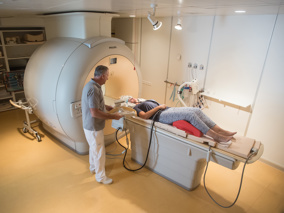Bladder cancer - non-muscle invasive
Bladder cancer has different stages of growth. Treatment depends on the stage of the tumor. If the tumor only grows in the cavity of the bladder and not in the muscle layer, it is called non-muscle invasive bladder cancer. This type of cancer is also called urothelial carcinoma. Non-muscle-invasive bladder cancer grows from the mucous membrane, the inner layer of the bladder. The tumor is on the surface of the bladder wall. This is an early stage of bladder cancer.
Non-muscle invasive bladder cancer is the most common. About 75 out of 100 people with bladder cancer have this form.
A tumor does grow in the muscle layer of the bladder, is called it muscle-invasive bladder cancer.
Read more about the symptoms, examinations, and treatment of non-muscle-invasive bladder cancer on this page.
Learn more about non-muscle invasive bladder cancer
Symptoms of non-muscle invasive bladder cancer
Non-muscle invasive bladder cancer does not cause pain in the bladder area. It almost never leads to urinary tract complaints. If there are signs or symptoms, it often involves:
- Blood in the urine (most common)
- Irritation during urination
- More frequent urination
There are complaints that can indicate a more extensive, muscle-invasive tumor:
- Pelvic pain
- Pain in the side (flank)
- Weight loss
- Palpable swelling (mass) in the lower abdomen
Bladder cancer check-ups
After any cancer treatment, monitoring or follow-up is essential to minimize complications and to detect and treat recurrent cancers (recurrences) early. The first check-up appointment is three months after the treatment and you will arrange the follow-up check-ups with your urologist. Your urologist is also the point of contact for questions about the disease or related topics.
Aftercare
Bladder cancer can have a major impact on the lives of patients and their loved ones. In bladder cancer, patients often have to deal with specific problems, such as urinary problems or sexuality, in addition to the complaints that occur in cancer patients in general, such as fatigue, pain, limitations in social life and various psychological problems such as anxiety and insecurity. You can contact our Center for Quality of Life for this.
Bladder cancer treatment
Once all the test results are known, you will have a conversation with the urologist. The urologist will discuss the results and the diagnosis with you. The urologist also discusses whether additional tests are needed.
The urologist will discuss with you:
- The results of the studies
- Your risk profile (low, medium or high)
- A preliminary treatment plan
Together you will look at the possible treatments. The final treatment plan depends on your risk profile, your health and what you discuss with the urologist.
The standard treatment is a TUR bladder procedure. This is a small operation in the bladder. Sometimes additional treatments are needed. That depends on your risk profile:
- Low-risk: one bladder lavage
- Medium risk: multiple bladder lavages
- High-risk: a TUR bladder and multiple bladder lavages.
Waiting
We want to inform you as well as possible about the waiting time per condition. We do this based on a prognosis of the current waiting list. The waiting time can vary from patient to patient for various reasons. Your attending physician will give you more information during your outpatient consultation.
-
10 days
First appointment
This is approximately how long it will take until you have your first appointment
-
8 days
Rapid diagnostics
This is approximately how long it will take before you can start rapid diagnostics at the NKI
-
16 days
Second opinion
This is approximately how long it will take before you come in for a second opinion at the NKI
 nl
nl





